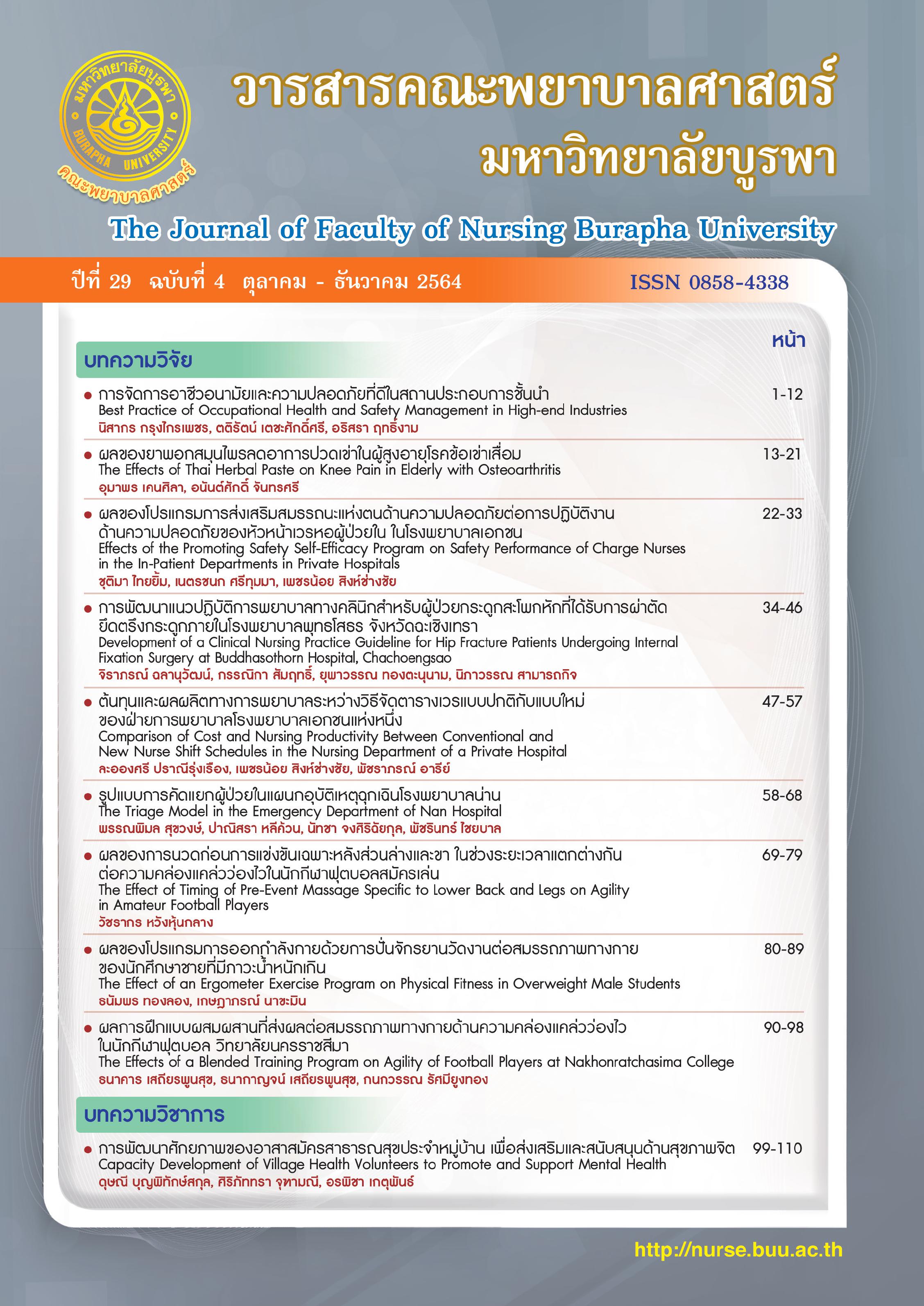การจัดการอาชีวอนามัยและความปลอดภัยที่ดีในสถานประกอบการชั้นนำ
คำสำคัญ:
อาชีวอนามัยและความปลอดภัย, การจัดการ, สมรรถนะพยาบาล, สถานประกอบการชั้นนำ, การปฏิบัติที่ดีบทคัดย่อ
การจัดการอาชีวอนามัยและความปลอดภัยช่วยลดอุบัติเหตุ ทำให้พนักงานมีความปลอดภัยและมีสุขภาพที่ดี ลดต้นทุนการผลิตและเพิ่มผลผลิต การวิจัยเชิงพรรณนาครั้งนี้มีวัตถุประสงค์เพื่อศึกษาการจัดการอาชีวอนามัยและความปลอดภัย ปัจจัยแห่งความสำเร็จ และสมรรถนะของพยาบาลวิชาชีพประจำสถานประกอบการในการจัดบริการพยาบาลอาชีวอนามัยในสถานประกอบการชั้นนำที่ได้รับรางวัลคุณภาพการจัดการอาชีวอนามัยและความปลอดภัยระดับชาติ จำนวน 5 แห่ง ผู้ให้ข้อมูลเป็นผู้มีส่วนได้ส่วนเสียกับการจัดการอาชีวอนามัยและความปลอดภัยในสถานประกอบการ ได้แก่ ผู้บริหาร เจ้าหน้าที่ความปลอดภัยในการทำงาน พยาบาลวิชาชีพ และผู้แทนพนักงาน รวมจำนวนทั้งสิ้น 32 คน ใช้วิธีบอกต่อในการเลือกผู้ให้ข้อมูล เก็บรวบรวมข้อมูลด้วยวิธีสนทนากลุ่ม การสัมภาษณ์เชิงลึก การสำรวจกระบวนการผลิตและห้องพยาบาลประจำสถานประกอบการ วิเคราะห์ข้อมูลโดยวิธีวิเคราะห์เนื้อหา
ผลการศึกษาพบว่า สถานประกอบการมีนโยบาย พันธกิจ ตลอดจนค่านิยมองค์กรด้านสุขภาพที่ชัดเจนและสื่อสารไปยังบุคลากรทุกระดับทราบและถือปฏิบัติ สร้างวัฒนธรรมความปลอดภัย นำมาตรฐานระบบการจัดการด้านอาชีวอนามัยและความปลอดภัยมาประยุกต์ใช้ มีการแบ่งปันข้อมูลและถอดบทเรียนภายในองค์กร และผู้มีส่วนได้ส่วนเสีย ในการจัดการอาชีวอนามัยและความปลอดภัยจะทำงานร่วมกัน การดำเนินงานทั้งเชิงรุกและเชิงรับครอบคลุมด้านสุขภาพ ความปลอดภัย และสิ่งแวดล้อมในการทำงาน การบริหารจัดการเพื่อการดูแลสุขภาพ พยาบาลวิชาชีพประจำสถานประกอบการแสดงบทบาทในการจัดบริการพยาบาลอาชีวอนามัยได้ตามสมรรถนะที่ผู้มีส่วนได้ส่วนเสียฯ คาดหวัง ประกอบด้วย สมรรถนะด้านการรักษาพยาบาลเบื้องต้น การส่งเสริมสุขภาพและการป้องกันโรค การบริหาร จัดการและประสานงาน ผลการศึกษาสามารถนำไปเป็นแนวทางในการจัดการอาชีวอนามัยและความปลอดภัยในสถานประกอบการ เริ่มต้นจากความตระหนักของผู้บริหาร การนำนโยบายด้านสุขภาพสู่การปฏิบัติ การดำเนินงานภายใต้ มาตรฐานสากล การมีส่วนร่วมของพนักงานทุกระดับพร้อมการพัฒนาศักยภาพ การประสานความร่วมมือระหว่างผู้มีส่วนได้ส่วนเสียฯ รวมถึงการจัดให้มีพยาบาลวิชาชีพที่มีความรู้ด้านพยาบาลอาชีวอนามัยปฏิบัติงาน
เอกสารอ้างอิง
Chailerdkongthanakul, N., & Aungsuroch, Y, (2019). Competencies of infirmary nurse. Journal of the police nurses. 11(1), 24-34.
Denzin, N. K., Lincoln, Y. S., & Giardina, M. D. (2006). Disciplining qualitative research. International Journal of Qualitative Studies in Education, 19(6), 769-782.
Haslam, C., O’Hara, J., Kazi, A., Twumasi, R., & Haslam, R. (2016). Proactive occupational safety and health management: Promoting good health and good business. Safety Science, 81, 99-108.
Holsti, OR (1969). Content analysis for the social sciences and humanities. Reading, MA : Addison-Wesley Publishing.
Institute of Occupational Safety and Health. (2018). Occupational health management in the workplace: A guide to the key issues of occupational health provision. Retrieved from https://iosh.com/media/4975/occu pational-health-management-in-the-work place-advice-guide.pdf
Khamhlom. N. (2016). A study of occupational health and safety performance among head safety supervisors in factories: Case study of Ubon Ratchathani province. Journal of Science and Technology Mahasarakham University, 35(5), 568-580. [In Thai]
Kongtip, P., Yoosook, W., & Chantanakul, S. (2008). Occupational health and safety management in small and medium-sized enterprises: An overview of the situation in Thailand. Safety Science, 46(9), 1356-1368.
Ministry of Industry. (2011). Ministry of Industry announcement: Industrial product standard occupational health and safety management system: Terms. The Royal Thai Government Gazette, 128(99), 11-19. [In Thai]
Ministry of Labour. (2005). Ministerial regulation on the prescribing of standard for administration and management of occupational safety, health and environment in relation to diving work B.E. 2548 (A.D.2005). Retrieved from ilo. org/dyn/natlex/docs/MONOGRAPH/96391/F450172617/THA96391%20Eng.pdf [In Thai]
Mohammadfam, I., Kamalinia, M., Momeni, M., Golmohammadi, R., Hamidi, Y., & Soltanian, A. (2017). Evaluation of the quality of occupational health and safety management systems based on key performance indicators in certified organizations. Safety and Health at Work, 8(2), 156-161.
Suthammasa. S. (2014). The role of employer and employee involvement on occupational safety and health. Journal of Safety and Health, 7(25), 6-12. [In Thai]
Wongwiseskul, S., Taoklam, B., & Tangpharkphoom, N. (2013). Sustainable management of health, safety, and occupational health in an industrial factory: A case study of a factory in Samut-Sakorn Province. The Journal of Boromarajonani College of Nursing, Nakhonratchasima, 19(1), 42-56.
Thailand Institute of Occupational Safety and Health (Public Organization). (2019). Occupational safety and health management system standard. Bangkok: Chayakorn printing. [In Thai]
The Labour Protection Act B.E. 2539. (1996). Ministerial regulation on the prescribing of standard for administration and management of occupational safety, health and environment. The Royal Thai Government Gazette. Vol. 123, Part 65 (a), p 7-11. [In Thai]
The Social Security Office, Ministry of Labour. (2020). Workmen’s Compensation Fund. Derived from https://www.sso.go.th/wpr/main/knowledge/ข้อมูลสถิติกองทุนเงินทดแทน_category_list-label_1_169_0 [In Thai]
Tukayo, I. J. H., & Hardy, S. (2020). The comparison of work productivity between nurses with insight of occupational health nursing (OHN) and of those without it. Jurnal Keperawatan, 11(2), 127-134.





